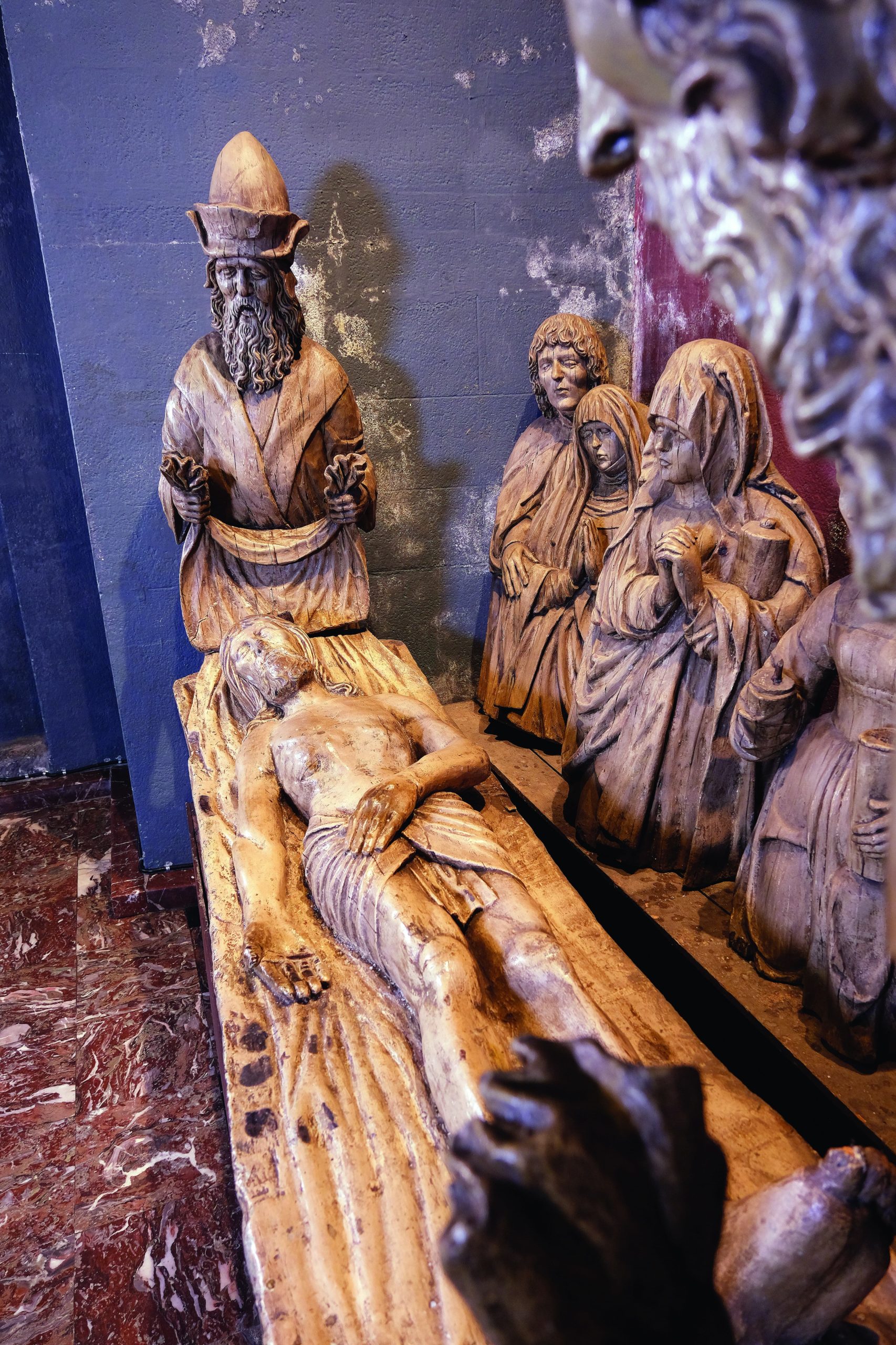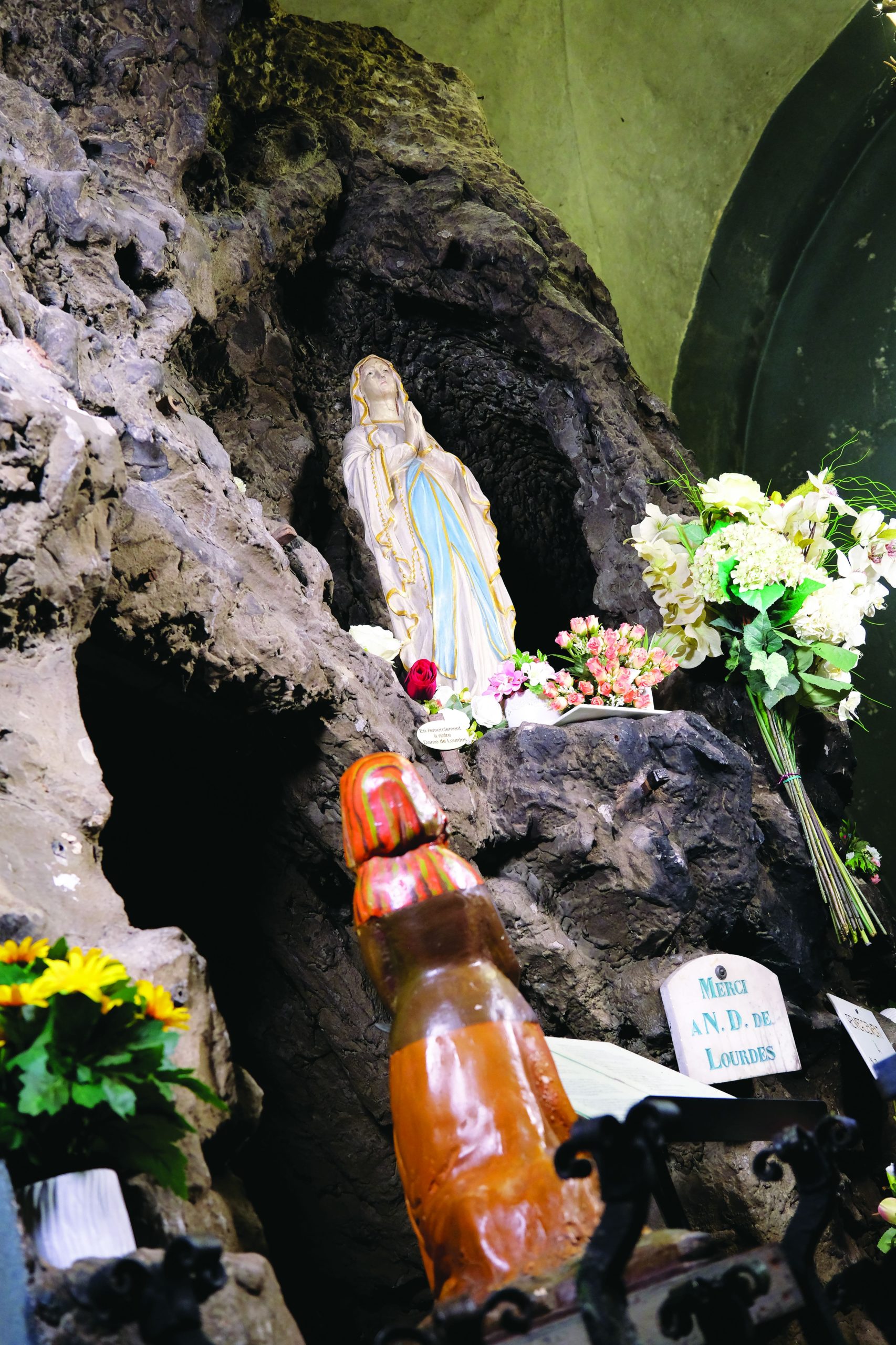Le Spais Trou et la Mise au tombeau
Le Spais Trou, littéralement « trou épais », est le nom wallon donné à l’endroit plongé dans l’obscurité qui se trouve au rez-de-chaussée de la tour. Sorte de refuge, on s’y abritait en cas de danger, en y accédant par une échelle et une ouverture aménagée dans la voûte. À l’entrée du Spais Trou se trouve aujourd’hui une grotte dédiée à Notre-Dame de Lourdes.
À côté de la grotte, un ensemble de sculptures constitue une Mise au tombeau. La Mise au tombeau est le dernier épisode de la Passion du Christ, moment où son corps est déposé au tombeau, entouré de ses proches et disciples. Cette œuvre est en chêne sculpté et peint en blanc, probablement lors de sa restauration de 1955. Datée du 16e siècle, cette Mise au tombeau proviendrait de l’ancien couvent des Trinitaires de Bastogne, supprimé lors de la Révolution française.
Cette scène a connu un grand succès dans l’art chrétien et les représentations de la Mise au tombeau suivent généralement le même schéma, avec les mêmes personnages. Le Christ est représenté allongé sur un linceul. Joseph d’Arimathie, à sa tête, et Nicodème, à ses pieds, tiennent les pans du tissu. Derrière le Christ, des personnages expriment le deuil : saint Jean soutenant la Vierge ainsi que le groupe des Trois Maries, soit Marie Jacobé, Marie-Madeleine et Marie Salomé (ou Marie de Béthanie, selon les versions).
Les personnages sont habillés et coiffés à la mode du 16e siècle, comme le montrent les couvre-chefs de Nicodème et de Joseph d’Arimathie ou encore la robe portée par Marie-Madeleine, à la mode bourguignonne.
De Spais Trou en de Graflegging
De Spais Trou, letterlijk « het dikke gat », is de Waalse benaming voor de verduisterde ruimte op de begane grond van de toren. Het was een soort schuilplaats, die gebruikt werd om dekking te zoeken in geval van gevaar. Men kon het via een ladder en een opening in het gewelf bereiken. Bij de ingang van de Spais Trou is nu een grot gewijd aan Onze Lieve Vrouw van Lourdes.
Naast de grot staat een groep personages die de Graflegging uitbeelden. De Graflegging is de laatste episode van het lijdensverhaal van Christus, het moment waarop zijn lichaam in het graf wordt gelegd, omringd door zijn familie en discipelen. Dit werk is gemaakt van gesneden eikenhout en is wit geschilderd, waarschijnlijk tijdens de restauratie in 1955. Deze Graflegging dateert uit de 16e eeuw en zou afkomstig zijn uit het voormalige Trinitaire klooster van Bastogne, dat tijdens de Franse Revolutie werd opgeheven.
Dit tafereel was erg populair in de christelijke kunst en voorstellingen van de Graflegging volgen meestal hetzelfde patroon, met dezelfde personages. Christus wordt afgebeeld liggend op een lijkwade. Jozef van Arimathea, aan zijn hoofd, en Nicodemus, aan zijn voeten, houden het kleed vast. Achter Christus staan rouwende figuren: Johannes die de Maagd ondersteunt en de groep van de Drie Maria’s, dat wil zeggen Maria Jacoba, Maria Magdalena en Maria Salome (of Maria van Bethanië, afhankelijk van de versie).
De figuren zijn gekleed en gekapt volgens de mode van de 16e eeuw, zoals blijkt uit de hoofdtooien van Nicodemus en Jozef van Arimathea en de jurk van Maria Magdalena, helemaal volgens de Bourgondische mode van toen.
The Spais Trou and the Entombment
The Spais Trou, literally « thick hole », is the Walloon name given to the darkened area on the ground floor of the tower. It is a sort of shelter, and it could be used to take cover in case of peril. It could be accessed via a ladder and an opening in the vault. At the entrance to the Spais Trou there is now a grotto dedicated to Our Lady of Lourdes.
Next to the grotto, a group of sculptures represent The Entombment of Christ. The Entombment is the last stage of Christ’s Passion, the moment when his body is laid in the tomb, surrounded by his next of kin and his disciples. This work is made of carved oak and has been painted white, presumably during its restoration in 1955. This 16th century Entombment is thought to have come from the former Trinitarian convent in Bastogne, which was abolished during the French Revolution.
This scene was very popular in Christian art, and representations of the Entombment generally follow the same pattern, with the same characters. Christ is depicted lying on a linen shroud. Joseph of Arimathea, at his head, and Nicodemus, at his feet, hold the cloth. Behind Christ, figures are depicted mourning: St John supporting the Virgin and the group of the Three Marys, i.e. Mary Jacoba, Mary Magdalene and Mary Salome (or Mary of Bethany, depending on the version).
The figures are dressed and styled in the fashion of the 16th century, as shown by the head covers of Nicodemus and Joseph of Arimathea and the dress worn by Mary Magdalene, in the Burgundian fashion.


